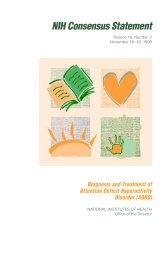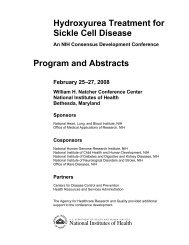Celiac Disease - NIH Consensus Development Program - National ...
Celiac Disease - NIH Consensus Development Program - National ...
Celiac Disease - NIH Consensus Development Program - National ...
You also want an ePaper? Increase the reach of your titles
YUMPU automatically turns print PDFs into web optimized ePapers that Google loves.
Serum IgA htTG in concert with small intestinal histology are a powerful diagnostic duo,and when both are performed correctly and are positive, provide a near absolute diagnosis ofuntreated or incompletely treated celiac disease. As a result, other diagnostic criteria such asclinical response to a gluten-free diet, histological response to a gluten-free diet, and glutenchallenge now play lesser roles in diagnosis.The remarkably high positive predictive value of IgA EMA or high-titer IgA htTGserology has led to debate as to whether endoscopy with biopsy is required for diagnosis—especially in instances where the pretest probability of celiac disease was already high. Eachpatient must be the final and individual arbiter of this debate, however, most expert celiacclinicians advocate strongly for histological confirmation of a diagnosis of celiac disease for thefollowing reasons: (1) celiac disease is defined by an enteropathy, not by the presence of a serumautoantibody; (2) positive serology in the absence of significant enteropathy does occur and doesnot predicate lifelong treatment with a gluten-free diet; (3) endoscopy with biopsy is readilyavailable in the United States and is relatively simple and safe; (4) it is difficult to either confirmor refute the diagnosis after dietary treatment is initiated; and (5) the cost of a false-positivediagnosis is enormous in that a patient may needlessly and fruitlessly adhere to an inconvenientand expensive gluten-free diet for decades while the actual etiology of their initial symptoms andsigns remains undiagnosed.A suggested clinical algorithm for diagnosis of celiac disease is shown in figure 1. Thefirst and essential step is to consider the diagnosis. The next is to determine—on the basis of thepatient’s clinical presentation, medical and family history, and available laboratory data—whether a diagnosis of celiac disease is highly likely (e.g., greater than 10 percent pretestprobability) or less likely. For those with a lower pretest probability, IgA htTG serology is thecurrent test of choice. A positive IgA htTG serology indicates the need for small bowel biopsy todiagnose celiac disease prior to lifelong treatment with a gluten-free diet. For those who arenegative by IgA htTG, a serum IgA level may be checked to exclude IgA deficiency; however,but this additional test has a relatively low diagnostic impact. Antigliadin serology is largelycounterproductive especially in individuals older than 2 years because of the plethora offalse-positive results in low-risk populations. For high-risk populations (e.g., greater than10 percent pretest probability), the likelihood of a false-negative IgA htTG serology may beunacceptably high; therefore, both serology and endoscopy with biopsy should be performed atthe outset. Additional diagnostic steps are needed in instances where IgA htTG serology ispositive but biopsy histology is reportedly normal, or where IgA htTG serology is negative butthe small intestinal morphology and inflammatory infiltrate are consistent with a celiac lesion.There is no place for a trial of a gluten-free diet prior to diagnostic testing for celiac disease.Unfortunately, in some instances, patients present on treatment with a gluten-free diet in theabsence of diagnostic pretreatment serology or histopathology. In such circumstances, glutenchallenge followed by serology and biopsy is needed to establish a secure diagnosis.When celiac disease is diagnosed, there should be an evaluation for deficiencies innutrients such as iron, folic acid, vitamin B12 and vitamin D. The patient should be educated onthe cause of intestinal injury and malabsorption in celiac disease, encouraged to adhere to alifelong gluten-free diet, and provided with access to expert nutritional counseling. The clinicaland serologic response to treatment should be monitored and reversal of any identifiednutritional deficiencies confirmed. With accurate diagnosis and appropriate treatment thesubstantial morbidity associated with unrecognized symptomatic celiac disease can be avoidedcompletely.34







